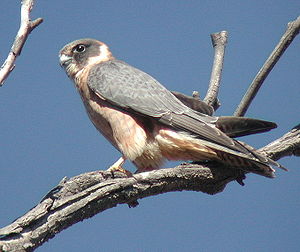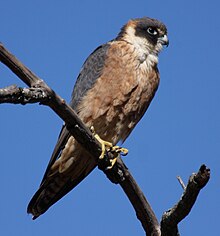Australian tree falcon
| Australian tree falcon | ||||||||||
|---|---|---|---|---|---|---|---|---|---|---|

Australian tree falcon |
||||||||||
| Systematics | ||||||||||
|
||||||||||
| Scientific name | ||||||||||
| Falco longipennis | ||||||||||
| Swainson , 1838 |
The Australian tree falcon ( Falco longipennis ) is a species of falcon that occurs from the Lesser Sunda Islands to Australia. The Australian mainland is the main area of distribution for this species. The Australian tree falcon is closely related to the Malay tree falcon .
The stock situation of the Australian tree falcon is given as least concern . There are three subspecies.
Appearance
anatomy
The Australian tree falcon reaches a body length of 30 to 36 centimeters, of which 11.4 to 14.7 centimeters are on the tail. The wing measures 24.1 to 27.2 centimeters. The beak length is 1.3 to 1.6 centimeters. The males weigh between 132 and 280 grams, the females between 190 and 365 grams. Apart from the difference in size, there is no noticeable gender dimorphism . The eyes are large compared to the size of the head and allow him to hunt in light conditions of two lux .
Adult birds
The crown of the head, the middle of the neck, the cheeks, the ear covers and a narrow strip of beard are blackish. The reins, a short stripe over the eyes, the chin, the throat, the front neck and the front chest are whitish to cream-colored. There is a white half-ring on the back of the neck, which ends in red-brown spots on the sides of the neck. The rest of the top of the body is black-gray. The tail plumage, which is also colored, has very fine white feather tips.
The lower chest and belly are reddish brown. The rump and the under tail-coverts are cream-colored. Black vertical lines can be found on the front neck, the chest and the under tail-coverts. The flanks are black stripes. The beak is blue-gray with a black tip. The wax skin, like the legs and feet, is pale yellow. The eye ring is blue-gray, the iris is dark brown.
Fledglings
Young birds are a little darker and more brownish than adult birds. The stripe above the eyes and the reins are red-brown, the parting is spotted red-brown. The two red-brown spots on the sides of the neck are more pronounced red-brown. Feet and legs are more dull in color than in adult birds.
Possible confusion
The Australian tree falcon is most likely to be confused with the peregrine falcon . There is also a possibility of confusion with the silver falcon , which is also found on the Australian mainland. In poor lighting conditions, the Australian tree falcon can also be confused with the gray-bearded falcon , which is of comparable body size and proportions. The wings, however, are shorter and wider.
Distribution area
The Australian tree hawk is a widespread bird in mainland Australia. It only does not occur in the arid and treeless regions in western Queensland, in the Nullarbor Plain , the Great Victoria Desert , the Gibson Desert , the Great Sand Desert and the Simpson Desert . It reaches its greatest density in the Australian Mallee ,
It is rare in Tasmania. In the south of New Guinea, on New Britain, the Moluccas and the Lesser Sunda Islands, it is a rare and usually not brooding guest there. In Tasmania it is mainly found in the summer half-year and is then more common in the north of the island than in the south. Australian tree falcons were particularly numerous in Tasmania during the long Australian drought in 1983. In addition to Tasmania, the Australian tree falcon can occasionally be seen on Flinders Island , the largest island in the Furneaux group at the eastern end of the Bass Strait between Tasmania and mainland Australia .
The Australian tree falcon is a partial migrant . Resident birds are found mainly in the semi-arid and arid regions, but also in the Atherton Tablelands and the coastal regions. In particular, the populations in the south of Australia migrate during the winter months to regions in which the food supply is more abundant.
habitat
The Australian tree falcon occurs in the tropical and temperate climatic zone of Australia and predominantly inhabits light forests and sparse, tree-lined open landscapes. Its habitat extends to the arid regions of mainland Australia as long as they have some tree population. It is usually found there near watering holes with some trees. However, this falcon is most common in sparse forests or in regions with a close-knit mosaic of unforested and wooded areas. Often he stays near watercourses. On the other hand, it avoids dense forests, but occurs in their peripheral zones along watercourses and roads. It also inhabits heaths, wetlands, pastureland, vineyards, and subalpine meadows. It can be found mainly in the lowlands and foothills, but some individuals migrate to the highlands in the warm months. It also occurs in urban areas.
Way of life and food
The Australian tree falcon lives solitary and prefers to hunt at dusk and dawn. Occasionally, however, it also uses the light from street lamps and catches insects at night. Often he sits high in trees in a hide waiting area. It mainly eats birds with a body weight of less than 75 grams, but prey animals with a weight of up to 350 grams have also been detected. Occasionally it hits small mammals and it also eats insects.
Typical prey includes sparrows , feral pigeons , parakeets , Laufhühnchen , coturnix , dwarf moorhens , plovers , snipes, introduced in Australia spotted dove , turtle dove , Friedenstäubchen different parakeet species such as the Eastern Rosella and Barnardsittich and finches.
During the hunt, the Australian tree falcon often flies just above the ground, the treetops or house roofs (so-called contour flight). He is also a hide hunter who lurks from a high vantage point for prey, which he then catches in rapid flight. He often beats flying birds by flying under them, then turning on his back and grasping with his fangs. He often kills birds that he grabs from above by biting the neck. The bite occurs regularly while still in flight. He then flies with the prey to a raised hide, where he plucks his prey.
Occasionally the Australian tree falcon also steals prey that has struck other species of birds of prey such as the banded goshawk or hawk falcon .
Reproduction
The reproductive biology of the Australian tree falcon has not yet been conclusively investigated. The breeding season generally falls in spring and summer. The breeding pair defends a breeding area during this time.
The Australian tree falcon does not build its own nest, but uses that of other bird species. These are often the nests of ravens and crows, but also those of wedge-tailed harriers , rabbit eagles and flute birds. The nests that are highest are preferred. The clutch consists of two to four eggs. The female lays the individual eggs 48 hours apart. Only one clutch is raised in each breeding season. The brood begins when the clutch is almost or completely done. The nestlings hatch largely synchronously. Both parent birds breed, but the female has the greater share of the breeding business. There is still no certainty about the duration of the breeding season; in general, the breeding season is between 28 and 35 days.
After the nestlings hatch, the parent birds either eat the eggshells or carry them out of the nest. The nestling period is 34 to 35 days. The nestlings weigh around 25 grams when they hatch and four weeks later have reached a weight of around 250 to 315 grams. They become fully fledged when they are around five weeks old. However, they occasionally fly out earlier if they have been disturbed at the nest. They are able to do this from around 28 days of age. The young birds are dependent on being completely or partially supplied with food by the parent birds for about another 12 weeks. They are first fed by the parent birds near the nest. About a week after leaving the nest, they fly towards the parent birds and steal their prey in the air.
literature
- Bruce M. Beehler, Thane K. Pratt: Birds of New Guinea; Distribution, Taxonomy, and Systematics . Princeton University Press, Princeton 2016, ISBN 978-0-691-16424-3 .
- J. Ferguson-Lees, DA Christie: Raptors of the World. Christopher Helm, London 2001, ISBN 0-7136-8026-1 .
- PJ Higgins (Ed.): Handbook of Australian, New Zealand & Antarctic Birds , Volume 2, Raptors to Lapwings, Oxford University Press, Oxford 1993, ISBN 0-19-553069-1 .
Web links
Individual evidence
- ↑ a b Handbook of the Birds of the World on the Australian Tree Falcon accessed on June 3, 2017.
- ↑ a b c d Higgins (Ed.): Handbook of Australian, New Zealand & Antarctic Birds . Volume 2, p. 268.
- ↑ a b Higgins (Ed.): Handbook of Australian, New Zealand & Antarctic Birds . Volume 2, p. 277.
- ↑ a b c d e Higgins (Ed.): Handbook of Australian, New Zealand & Antarctic Birds . Volume 2, p. 271.
- ↑ a b c d e Higgins (Ed.): Handbook of Australian, New Zealand & Antarctic Birds . Volume 2, p. 269.
- ↑ Higgins (Ed.): Handbook of Australian, New Zealand & Antarctic Birds . Volume 2, p. 270.
- ↑ a b Higgins (Ed.): Handbook of Australian, New Zealand & Antarctic Birds . Volume 2, p. 275.
- ↑ Higgins (Ed.): Handbook of Australian, New Zealand & Antarctic Birds . Volume 2, p. 272.
- ↑ a b Higgins (Ed.): Handbook of Australian, New Zealand & Antarctic Birds . Volume 2, p. 276.


